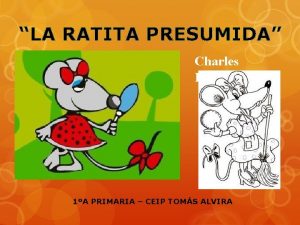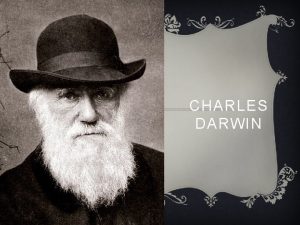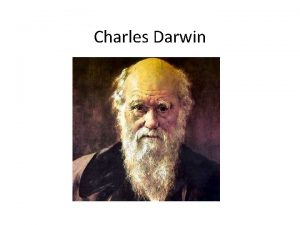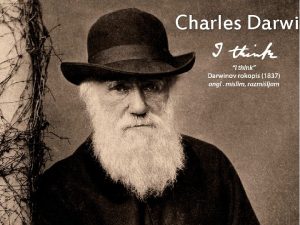Charles Darwin Charles Darwin studied the diversity of






- Slides: 6

Charles Darwin • Charles Darwin studied the diversity of life (biodiversity). • Many of ideas came from when he observed Finches ( a bird species) on the Galapagos Islands.

When observing different species of Finches, Darwin noticed their beaks varied in shape and sizes—birds on similar islands had similar beaks. Ancient Armadillo Modern Armadillo

Beak size and shape is an example of an adaptation. Adaptation- an inherited trait which assists an organism or species in its survival (BASED ON THE ENVIRONMENT). -Biological adaptations include changes in structures, behaviors, or physiology that enhance survival and reproductive success in a particular environment. -any traits that are beneficial to an organism in its environment are said to have adaptive value. -organisms that have beneficial traits have greater “fitness”. -Example: Better eye-sight, stronger legs • Over time, The number of individuals that have advantageous characteristics will increase.

The Theory of Evolution By Natural Selection • This was Darwin’s theory of evolution. Natural Selection- the process by which individuals that are better adapted to their environment survive and reproduce more successfully than less adapted individuals.

Darwin’s Main Points in the Theory of Evolution by Natural Selection 1. Genetic Variation- organisms within a population have different traits. 2. Overproduction- Within a population more offspring are born than can possibly survive. 3. Struggle for existence/Competition- organisms compete for resources. 4. Survival of the Fittest (Differential survival and reproduction)The best adapted individuals survive and reproduce, passing on the favorable variations to their offspring.

Modeling-Annotate to identify the Key Points Lumbricus terrestris is a large, reddish worm species native to Europe. Some individuals of the population eat at night (nocturnal) and some eat during the day (diurnal). They feed on the same organic matter (plants and fruit). Some birds that eat during the day prey on these diurnal worms. The nocturnal worms are in their burrows during this time. Each spring when the worms reproduce, about 500 offspring are produced but only 100 of these 500 ever become old enough to reproduce. Identify (and record in graphic organizer) each component of Natural Selection.











